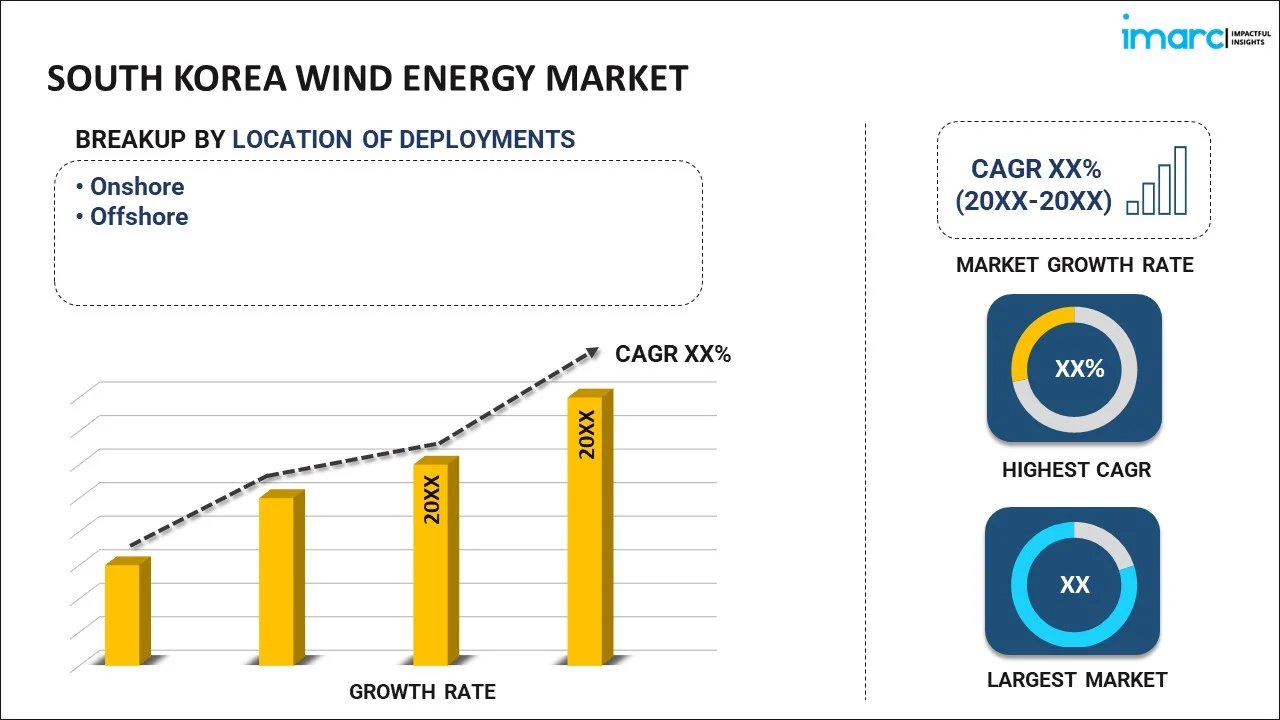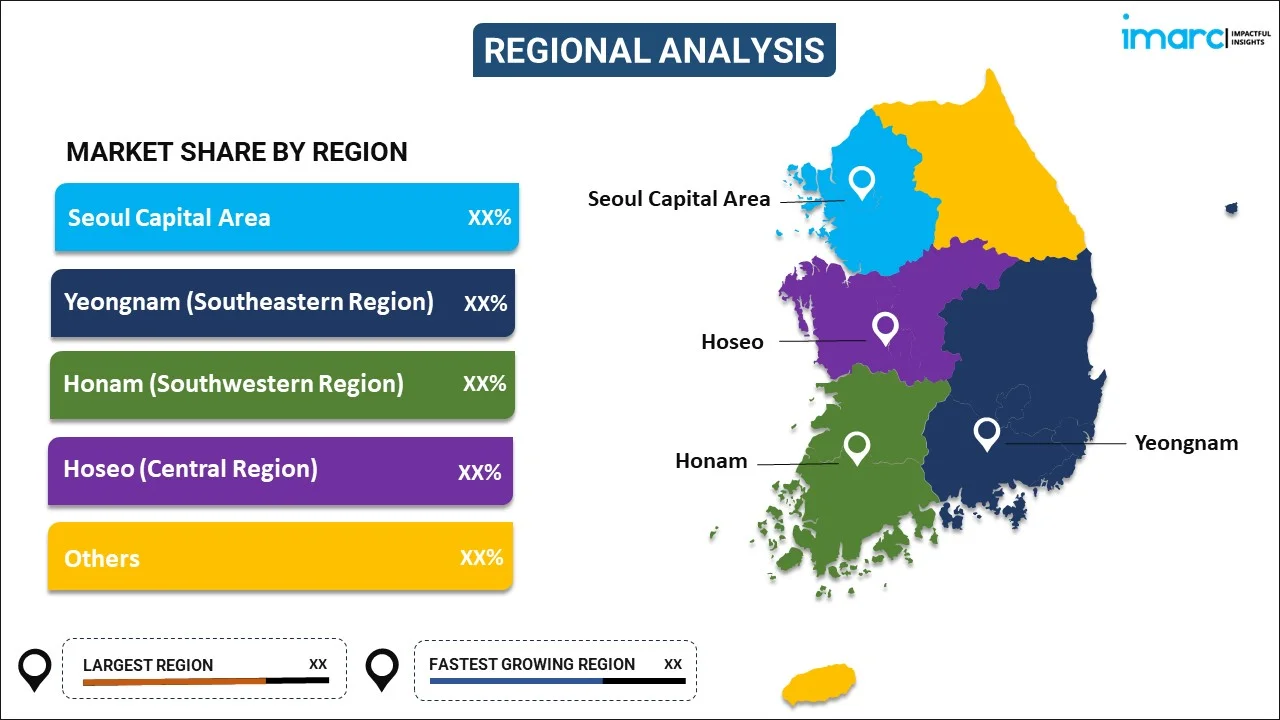
South Korea Wind Energy Market Report by Location of Deployment (Onshore, Offshore), and Region 2024-2032
South Korea Wind Energy Market:
South Korea wind energy market size is projected to exhibit a growth rate (CAGR) of 7.32% during 2024-2032. The increasing focus of government bodies on minimizing greenhouse gas emissions is augmenting the market across the country.
|
Report Attribute
|
Key Statistics
|
|---|---|
|
Base Year
|
2023 |
|
Forecast Years
|
2024-2032
|
|
Historical Years
|
2018-2023
|
| Market Growth Rate (2024-2032) | 7.32% |
South Korea Wind Energy Market Analysis:
- Major Market Drivers: The increasing need for sustainable power sources to meet escalating energy demands is bolstering the market across the country. Moreover, the growing number of onshore and offshore wind projects is also acting as a significant growth-inducing factor.
- Key Market Trends: South Korea's geographic location offers natural advantages, which is elevating the market. Apart from this, the wide coastlines offering strong wind conditions will continue to bolster the market in the coming years.
- Competitive Landscape: The report has provided a comprehensive analysis of the competitive landscape in the market. Also, detailed profiles of all major companies have been provided.
- Geographical Trends: The social acceptance of renewable energy is propelling the market in the Seoul Capital Area. Additionally, the broader goals of energy security are catalyzing the market in Yeongnam (Southeastern Region). Apart from this, the elevating public awareness is also fueling the market in Honam (Southwestern Region). Furthermore, advancements in wind turbine material are bolstering the market across Hoseo (Central Region).
- Challenges and Opportunities: The limited availability of land is hindering the market. However, the widespread focus on offshore wind development will continue to fuel the market over the forecasted period.
South Korea Wind Energy Market Trends:
Shift Towards Offshore Development
The increasing focus on new capacity, owing to the shift toward offshore wind projects, is catalyzing the market. Offshore locations, particularly in the southwestern coastal areas, provide more consistent and stronger wind speeds. In September 2024, EDF Renewables acquired Shell’s 100% stake in West Sea Energy, the entity behind an offshore wind project set to take shape in southwestern South Korea with a capacity of up to 1.5GW. This is escalating the South Korea wind energy market demand.
Private Sector Participation
The market is seeing increased involvement from private companies, both international and domestic. Major corporations, particularly in the technology, energy, and industrial sectors, are investing extensively in wind energy projects, driven by the country’s renewable energy targets and the shift towards sustainability. In September 2024, the Netherlands-based logistics company Mammoet and Samyang Marine Group entered into a partnership to provide transport solutions for South Korea’s offshore wind sector. This is positively influencing the South Korea wind energy market outlook.
Emphasis on Energy Transition
As the country seeks to minimize its reliance on fossil fuels and achieve carbon neutrality by 2050, wind energy is positioned as a key pillar of its clean energy strategy. This focus on decarbonization has prompted increased investment in renewable energy infrastructure, particularly in wind farms, which offer a scalable and clean solution to the country’s energy needs. In March 2024, Vestas secured a 77 MW order with GS E&R for the YD1 wind farm in Gyeongsang-do, South Korea, that includes supply and supervision of the installation of 18 V136-4.2 MW wind turbines delivered in 4.3 MW operating mode. This is expanding the South Korea wind energy market outlook report.
South Korea Wind Energy Industry Segmentation
IMARC Group provides an analysis of the key trends in each segment of the market, along with the South Korea wind energy market forecasts at the country and regional levels for 2024-2032. Our report has categorized the market based on the location of deployment.
Breakup by Location of Deployment:

- Onshore
- Offshore
The report has provided a detailed breakup and analysis of the market based on location of deployment. This includes onshore and offshore.
South Korea's wind energy market is divided between onshore and offshore projects, with distinct opportunities in each. The country's mountainous terrain constrains onshore wind development. In contrast, offshore wind provides significant potential, particularly in South Korea's coastal regions, where consistent and strong winds can support large-scale projects. The government is extensively prioritizing offshore wind development, particularly in the waters off the southwest coast, where large-scale floating wind farms are being considered. Offshore wind projects can make them a central focus for the country's renewable energy goals. This is expanding the South Korea wind energy market share.
Breakup by Region:

- Seoul Capital Area
- Yeongnam (Southeastern Region)
- Honam (Southwestern Region)
- Hoseo (Central Region)
- Others
The South Korea wind energy market research report has also provided a comprehensive analysis of all the major regional markets, which include Seoul Capital Area, Yeongnam (Southeastern Region), Honam (Southwestern Region), Hoseo (Central Region), and Others.
In the Seoul Capital Area, high population density is propelling the market. The Yeongnam (Southeastern) region, known for its industrial base, stands out as a hub for wind energy, particularly offshore projects, owing to favorable wind conditions in coastal areas like Jeolla province. Hoseo (Central Region) has moderate wind potential, though it faces challenges from land-use competition. Other regions, such as the islands and less populated coastal areas, also offer strong offshore wind prospects, further contributing to South Korea's renewable energy goals. As per the South Korea Wind energy market analysis report, this is fueling the market.
Competitive Landscape:
The market research report has also provided a comprehensive analysis of the competitive landscape in the market. Competitive market price analysis, such as market structure, key player positioning, top winning strategies, competitive dashboard, and company evaluation quadrant, has been covered in the report. Also, detailed profiles of all major companies have been provided.
South Korea Wind Energy Market Recent Developments:
- September 2024: EDF Renewables acquired Shell’s 100% stake in West Sea Energy, the entity behind an offshore wind project set to take shape in southwestern South Korea with a capacity of up to 1.5GW.
- September 2024: The Netherlands-based logistics company Mammoet and Samyang Marine Group entered into a partnership to provide transport solutions for South Korea’s offshore wind sector.
- March 2024: Vestas secured a 77 MW order with GS E&R for the YD1 wind farm in Gyeongsang-do, South Korea, that includes supply and supervision of the installation of 18 V136-4.2 MW wind turbines delivered in 4.3 MW operating mode.
South Korea Wind Energy Market Report:
| Report Features | Details |
|---|---|
| Base Year of the Analysis | 2023 |
| Historical Period | 2018-2023 |
| Forecast Period | 2024-2032 |
| Units | US$ Million |
| Scope of the Report | Exploration of Historical Trends and Market Outlook, Industry Catalysts and Challenges, Segment-Wise Historical and Predictive Market Assessment:
|
| Location of Deployments Covered | Onshore, Offshore |
| Regions Covered | Seoul Capital Area, Yeongnam (Southeastern Region), Honam (Southwestern Region), Hoseo (Central Region), Others |
| Customization Scope | 10% Free Customization |
| Report Price and Purchase Option | Single User License: US$ 3699 Five User License: US$ 4699 Corporate License: US$ 5699 |
| Post-Sale Analyst Support | 10-12 Weeks |
| Delivery Format | PDF and Excel through Email (We can also provide the editable version of the report in PPT/Word format on special request) |
Key Questions Answered in This Report:
- How has the South Korea wind energy market performed so far, and how will it perform in the coming years?
- What has been the impact of COVID-19 on the South Korea wind energy market growth?
- What is the breakup of the South Korea wind energy market on the basis of the location of deployment?
- What are the various stages in the value chain of the South Korea wind energy market?
- What are the key driving factors and challenges in the South Korea wind energy?
- What is the structure of the South Korea wind energy market, and who are the key players?
- What is the degree of competition in the South Korea wind energy market?
Key Benefits for Stakeholders:
- IMARC’s industry report offers a comprehensive quantitative analysis of various market segments, historical and current market trends, market forecasts, and dynamics of the South Korea wind energy market from 2018-2032.
- The research report provides the latest information on the market drivers, challenges, and opportunities in the South Korea wind energy market.
- The study maps the leading, as well as the fastest-growing, markets. It further enables stakeholders to identify the key country-level markets within the region.
- Porter's five forces analysis assists stakeholders in assessing the impact of new entrants, competitive rivalry, supplier power, buyer power, and the threat of substitution. It helps stakeholders to analyze the level of competition within the South Korea wind energy industry and its attractiveness.
- The competitive landscape allows stakeholders to understand their competitive environment and provides insight into the current positions of key players in the market.
Need more help?
- Speak to our experienced analysts for insights on the current market scenarios.
- Include additional segments and countries to customize the report as per your requirement.
- Gain an unparalleled competitive advantage in your domain by understanding how to utilize the report and positively impacting your operations and revenue.
- For further assistance, please connect with our analysts.
 Inquire Before Buying
Inquire Before Buying
 Speak to an Analyst
Speak to an Analyst
 Request Brochure
Request Brochure
 Request Customization
Request Customization




.webp)




.webp)












